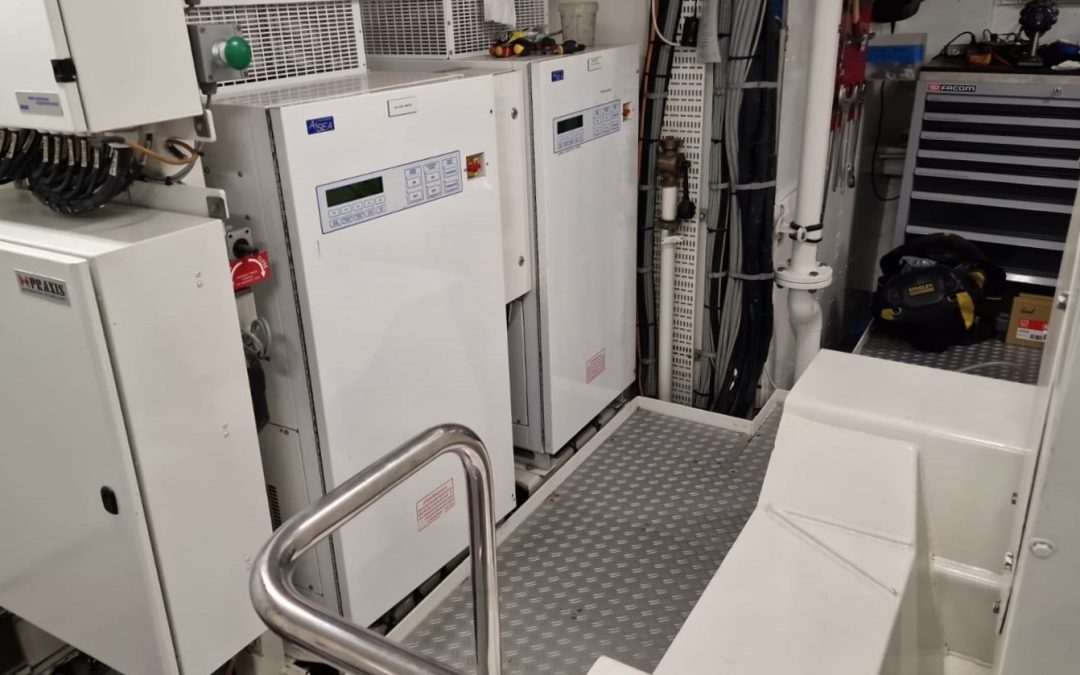Shore power converters equipped with the Seamless Transfer Option (STO) provide a critical advantage, enabling uninterrupted transitions between power sources. Whether onboard systems include STO or require manual operations, understanding these processes ensures efficient and safe transitions, ultimately preserving equipment integrity and optimizing performance. Below is an in-depth guide to handling power transitions for systems without STO and those equipped with it.
Operating Systems Without the Seamless Transfer Option
For systems not equipped with STO, power transitions must be performed manually, demanding meticulous attention to detail to avoid equipment damage.
Start by pressing the CONVERTER POWER ON button on the control panel. This action activates the converter’s output terminals, which is indicated by the illumination of the green ON indicator LED. At this point, it is critical to utilize external switchgear to facilitate the power transfer using a “break-before-make” method. This means the generator’s connection must be completely disengaged before the converter is connected to the ship’s distribution grid.
Operating the generator and converter in parallel is strictly prohibited. Allowing both systems to supply power simultaneously can cause severe damage to both the converter and the generator.
To ensure safety and reliability, the process must be executed with precision, adhering to the prescribed sequence and timing. This ensures smooth transitions and protects onboard electrical infrastructure from unnecessary wear and potential failures.

Operating Systems Equipped with the Seamless Transfer Option
For systems equipped with STO, the process is automated, offering smoother transitions and reducing the likelihood of human error. Here’s how to manage transitions with STO-equipped systems:
Prepare the System
Ensure the converter is in the Standby State. Press the GENERATOR POWER button to display generator voltage and phase details. For systems with multiple generators, use the F1 and F2 buttons to select the appropriate generator.
Monitor Generator Metrics
The metering display will provide information on generator voltage and form but will not show current, kW, or kVA values. To determine the generator’s operational status, rely on the SHIP’S POWER indicator LEDs. The SHIP’S POWER – CONVERTER LED indicates the converter is supplying power, while the SHIP’S POWER – GENERATOR LED indicates generator power.
Both LEDs must never be illuminated simultaneously. At any given time, only one power source should supply the ship’s distribution grid to prevent system conflicts.
Initiate the Seamless Transfer
- If the Generator is Active: Press the SHIP’S POWER – CONVERTER button. The converter will synchronize with the generator by matching its voltage, frequency, and phase. Once synchronization is achieved, the system temporarily places the generator and converter in parallel before disengaging the generator’s circuit breaker. This process typically completes in under 5 seconds, ensuring uninterrupted power while allowing the generator to be safely shut down.
- If the Generator is Offline: The converter will immediately assume the load upon pressing the CONVERTER button, bypassing the synchronization phase. However, if the generator is not ready (e.g., operating outside acceptable voltage or frequency limits), the transfer will be aborted.
Monitor Post-Transfer Performance
After the transfer is complete, it is essential to monitor the converter’s load currents and voltages to ensure they remain within system ratings. Additionally, observe shore power voltage and current levels to prevent tripping breakers. Published rating curves and metering features can provide detailed insights into performance and identify potential areas of concern.
Other Important Considerations
The Seamless Transfer Option utilizes momentary control signals to operate switchgear contactors or circuit breakers, enabling the smooth connection of generators to the ship’s distribution bus. Each control pulse lasts 0.6 seconds for both open and close commands. This precise timing ensures the system’s integrity during transitions and reduces the risk of misoperation.
By automating synchronization and transfer processes, STO eliminates the need for manual intervention, significantly minimizing errors and ensuring the system maintains uninterrupted power.
Whether your system includes STO or requires manual handling, adherence to these guidelines ensures optimal operation and safety of ASEA’s Liquid-Cooled LCZ Shore Power Converters. For further technical assistance, refer to the product manual or consult an ASEA product specialist for tailored guidance.

